CES: JVC Unveils 1080P HD-ILA Projector and 110-inch HDTV
By Chris Boylan
Mine is Bigger
CES is an event of superlatives. Apparently bigger is better in the land of TV manufacturers. Last year, Panasonic unveiled a 103-inch plasma, which bested rivals Samsung and LG by one inch. This year, Sharp displayed a
108-inch LCD flat panel, which many assumed would be the largest one-piece HDTV shown at the show. Not so...
JVC held a press conference today to share their new products and strategies for future growth. And while they were at it, they showed off a fully functional prototype 110-inch (diagonal) one-piece rear-projection HDTV, featuring HD-ILA technology (their propietary variation of LCOS) and Full HD 1080p resolution. Although Sharp stated at the show that they plan to commercialize their 108-inch set, JVC made no such claims and may have created this television simply as a technology statement (i.e., because they can).
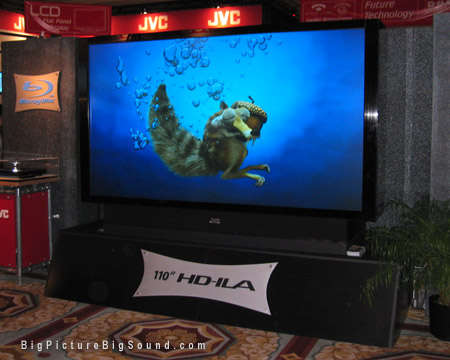
JVC's 110-inch HD-ILA HDTV doesn't need to be wall-mounted. It *IS* the wall.
Perhaps more interesting (and certainly more practical), JVC also unveiled their new HD-ILA RPTV models in real-world sizes (58 inches and 65 inches). The JVC HD-58S998 ($3,299.95, January) and HD-65S998 ($4,199.95, March) each feature 1080p resolution, a new ATSC/QAM/NTSC tuning system with twin view, screen freeze and swap picture, two 1080p-capable HDMI inputs, two component inputs and a PC input.
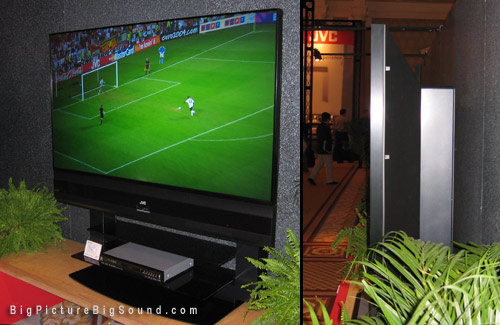
JVC's HD-58S998 features a 10.7-inch depth and can be stand or wall-mounted.
Most interesting is the slim depth of these rear projections sets, just 10.7 inches for the 58-inch model and 11.6 inches for the 65-incher. The TV's feature a fully flat finished back cabinet and optional stand with built-in wire management, so the sets can live happily out in the middle of a living room or great room without fear of exposing unsightly cables and unfinished backsides. There is even an optional wall-mount kit for each.
If you simply
must have a 100-inch (or larger) TV image, then consider JVC's new
DLA-HD1 1080p 3-chip D-ILA front projector. This home theater projector is expected to begin shipping in April with a list price of $6,299. It features 1920x1080 (1080p) resolution as well as an impressive 15,000:1 native contrast ratio (and that's without the help of an iris).
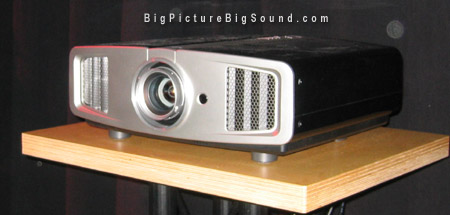
JVC's DLA-HD1 Projector features 1080p resolution and a 15,000:1 native contrast ratio.
JVC had the HD1 projector on active display in a dark room, next to a Sony VPL-VW50 ($4,999, available now), to highlight the differences between their 1080p projector and Sony's. Both projected identically sized images (around 130 inches across) on identical Stewart screens. Both projectors are based on LCOS (Liquid Crystal on Silicon) designs so it should be a fairly level playing field.
I can't vouch for the exact set-up of both units, but a JVC rep said that each was left in its factory (un-tweaked) state, with the picture set to "Cinema" mode. Cinema mode of most TVs usually sets the brightness and contrast to reasonable levels. In the demo, the colors on the VPL-VW50 looked a bit muted and the deep blacks slightly grey when compared to the bright saturated colors and deeper blacks on the image projected by the JVC. But it would be unwise to draw significant conclusions from one demo. We hope to get a sample of the HD1 into the BPBS labs for a full review later this Winter.
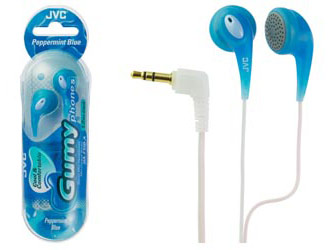
JVC's Gumy ear buds are available in cool colors like "peppermint blue."
These Buds are For You
On the audio side of the house, JVC anounced the success of their colorful "Gumy" earbud headphones, stating that these buds have been among the top-selling headphones since their introduction. I'm sure the $9.95 price point doesn't hurt. JVC is expanding the palate of color offerings from five to eight, with trendy names like peppermint blue, olive black and valencia orange.
JVC also exhibited a new pair of noise-cancelling headphones, the HA-NC80 with dual mode settings - a "wide mode" for cancelling noise with a wide frequency range (e.g., airplane engines), and a "Low mode" for cancelling low frequency noises, such as busses or trains. In quieter environments, you can use simply turn the noise reduction off and still use them as regular headphones.
Look Ma, No Wires!
JVC also showed off two new home-theater-in-a-box systems in their new "Sophisti" line, the DD3 ($995, April) and DD-8 ($1,995, TBD). Both systems feature the new JVC Network Media Player, which, in addition to wireless playback of digital files stored on a computer, offers "USB Host." This means you can connect a wide range of digital devices directly to the system, including flash audio players, USB drives, digital cameras and card readers for photo and video playback, as well as listening to music files.
The player is DLNA (Digital Living Network Alliance) certified, which means that files can be accessed from other DLNA-compliant devices. The main unit also includes a DVD player, built-in surround processor to decode Dolby Digital, DTS and Dolby Pro Logic II soundtracks and an HDMI output.
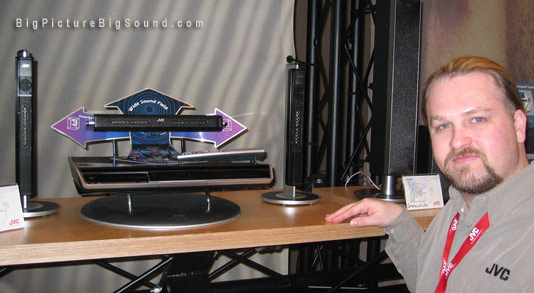
Mike Exler from JVC proudly shows off the Sophisti DD-3 system.
Seeing these Sohpisti systems in a PowerPoint presentation made me think they included large floor-standing tower speakers. The DD-8 does, but the DD-3's speakers are cute little 15-inch high mini-towers with included circular stands. Bass output is augmented in each system by a powered subwoofer.
The Future of Television?
In the back of their demo suite, JVC showed off three prototype RPTVs (rear projection televisions), an LED-backlit HD-ILA model, a 3D model (requires goggles), and an ultra-cool superwide 2.35:1 widescreen TV in a 66-inch size. We were not allowed to take photos of these prototypes so you'll just have to imagine a widescreen TV, stretched out so it's even wider. It's shape is optimized to fit the exact dimensions of most modern CinemaScope movies, removing the black bars that you would get viewing these films on a standard 16:9 HDTV display. Of course, this means you'll get black or grey bars on the sides when viewing standard HDTV content, but such is the price you pay as a purist movie lover.
Dates and pricing of these new models were not available as these are still under development.




